Exploring Japanese Sconces: Design and Culture
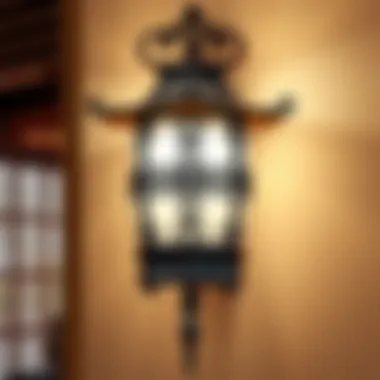
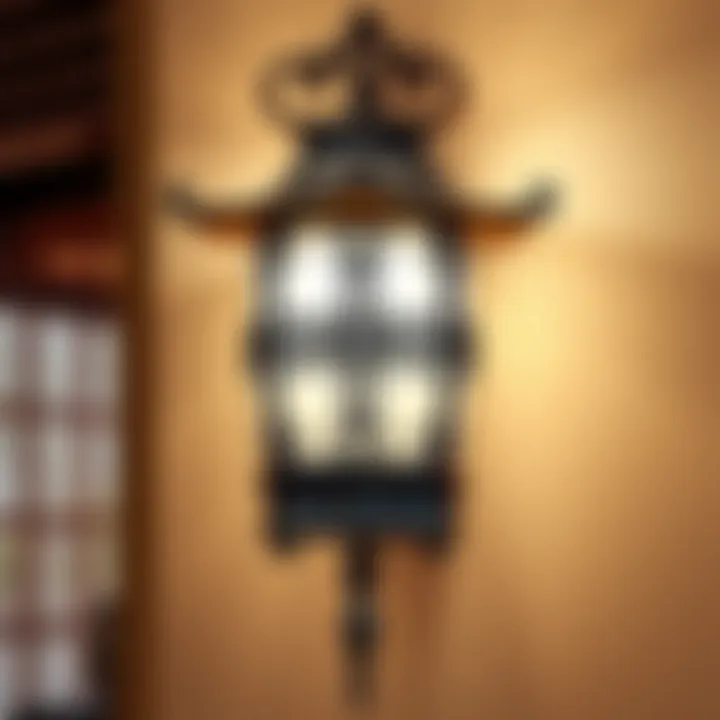
Intro
Japanese sconces, with their delicate craftsmanship and thoughtful design, provide a unique blend of aesthetics and functionality that adds depth to any living space. These sconces are not merely fixtures for holding light but are also carriers of culture and history. They reflect a philosophy that values simplicity, balance, and the beauty found in nature.
As we embark on this exploration of Japanese sconces, our aim is to uncover what makes them stand out in both contemporary and traditional interiors. We will navigate through various styles, materials, and the historical context that has influenced these fixtures over time. Understanding these elements can aid homeowners, interior designers, and furniture enthusiasts in making informed decisions about integrating these lighting pieces into their spaces.
Preface to Japanese Sconces
Japanese sconces serve not just as lighting fixtures, but also as reflections of rich traditions and a keen sense of aesthetics that has transcended centuries. They integrate beauty with function seamlessly, illuminating spaces while adding a unique charm that is deeply rooted in Japanese culture. This article endeavors to unpack the significance of Japanese sconces in various settings, shedding light on their design intricacies, historical evolution, and cultural importance.
Defining the Japanese Sconce
A Japanese sconce can be described as a wall-mounted light fixture that often exudes simplicity and refinement. Traditionally crafted, these sconces highlight the use of natural materials and emphasize minimalist yet deliberate designs. Commonly, they are framed in wood, complemented by materials like washi paper or ceramic, which create a beautifully diffused light. In stark contrast to more ornamental Western designs, Japanese sconces favor understated elegance, where every contour and shadow contributes to the overall ambience.
Aspects that particularly distinguish them include their:
- Material Choices: Wood, paper, and metal play significant roles in their construction, reflecting the Japanese reverence for nature.
- Design Influences: Many designs draw inspiration from traditional Japanese aesthetics, such as Zen principles and the use of space and light in harmony.
- Functional Versatility: These sconces serve a dual purpose; while providing light, they also act as vital components in enhancing the interior decor.
Historical Background and Evolution
To appreciate Japanese sconces fully, it helps to explore their historical context. This journey takes us back to the Edo period, when authenticity and simplicity in art and design began to flourish. Originally, lighting in Japan relied heavily on oil lamps and candles, but as the country modernized, so did its approaches to illumination. The transition from traditional to modern forms saw sconces evolving in both function and aesthetic.
Emergence of materials like washi paper allowed for softer light diffusion, thus creating an ambient glow ideal for evening gatherings or contemplative spaces. In contemporary times, designers have rediscovered these fixtures that, while modernized, still retain the essence of their heritage. Today's sconces often find themselves at home in both traditional and modern settings, embodying the fusion of past and present.
"Every light tells a story, and Japanese sconces narrate tales of artistry, tradition, and nature that have stood the test of time."
Furthermore, modern iterations embrace sustainability, incorporating eco-friendly materials and energy-efficient lighting, signifying a shift towards more responsible consumption. This evolution keeps Japanese sconces relevant in an ever-changing design landscape, appealing to a diverse audience ranging from homeowners to interior designers who seek both functionality and aesthetic appeal.
Cultural Significance of Lighting in Japan
Lighting, particularly in the context of Japanese culture, is not merely a functional aspect; it serves as a profound element reflecting aesthetics, spirituality, and societal norms. The role of light within homes and public spaces in Japan is intertwined with concepts of harmony, balance, and tranquility. This section will delve into how light functions as a medium of expression in Japanese society, emphasizing the intentional choices made in the use of lighting fixtures like sconces.
Light as a Symbol of Harmony
In Japan, light is often viewed as a symbol of harmony and balance. Traditional beliefs suggest that light brings spiritual energy into a space. This is more than just a vague aspiration; it echoes through various aspects of life. In homes, light is often designed to create an atmosphere that feels natural and peaceful.
For instance, the use of soft, warm light instead of harsh, bright illumination reflects a deeper understanding of how people interact with their environment. Japanese sconces may be strategically placed to cast gentle shadows that dance along the walls, reminding one to take a moment and appreciate their surroundings.
"The power of illumination in Japan lies in its ability to transform, to create spaces where calmness lingers, and one can find solace."
These sconces do more than just illuminate; they invite tranquility into every corner of a room. The kind of light produced and how it interacts with surfaces can influence mood and activity. For example, a dimmer setting may suggest relaxation, whereas brighter light can prompt conversation or hours spent engaging with family or friends.
Traditional Uses in Japanese Homes
The integration of light in a Japanese home is steeped in tradition. Historically, homes utilized natural light effectively; sliding shoji screens and tatami mats were often designed to let in daylight while providing privacy. Lighting fixtures were then introduced to complement these designs.
In many homes, traditional sconces serve not only as lighting sources but also as pieces of art. They are often crafted from materials like wood, paper, or bamboo, reflecting a style that emphasizes simplicity and beauty. Functions of sconces in Japanese homes include:
- Ambiance Creation: Sconces soften harsh overhead lights, creating layers of light that enhance the room's character.
- Guiding Movement: Strategically placed lighting guides visitors—important in homes where paths change from room to room.
- Cultural Practices: Lighting is often central in various ceremonies, such as tea traditions, where the setting's ambiance must align with the spirit of the moment.
Design Elements of Japanese Sconces
Japanese sconces are not just fixtures that throw light; they are a harmonious blend of function and form. The design elements in these sconces play a vital role in both aesthetics and utilitarian value. The right design can elevate a space, reflecting both traditional values and modern ideals.
Materials Commonly Used
Wood
Wood holds a special place in Japanese aesthetics. It embodies natural beauty and warmth. Many Japanese sconces feature fine wooden frames, often made from cedar or pine. This choice is not merely for sturdiness; the rich grain patterns can add character to any room. A significant characteristic of wood is its versatility. It can either be polished for a sleek look or left with a raw finish, each providing a different ambiance. Wood, however, is susceptible to moisture and may require appropriate care. Still, its unique ability to bring a touch of nature indoors often outweighs these challenges for many homeowners.
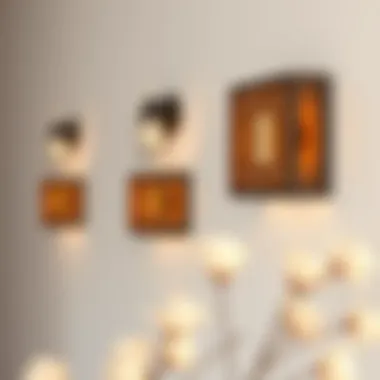
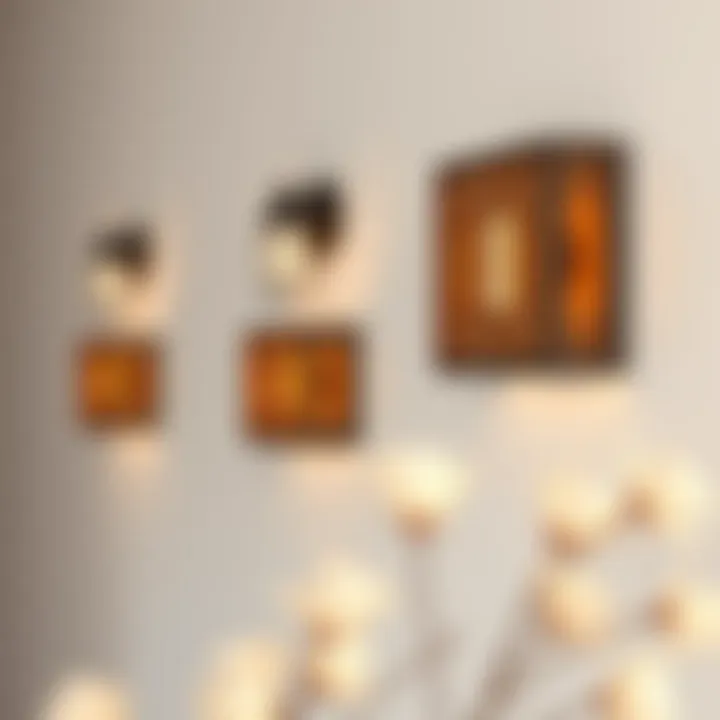
Paper
Then there’s paper, a defining feature in many traditional Japanese sconces. Rice paper, or "washi," is widely used for its translucence, allowing light to filter softly and create a gentle glow. This characteristic makes paper an ideal element for achieving a tranquil atmosphere. While some may see paper sconces as fragile, their ethereal beauty can dramatically transform a space. However, it’s essential to consider where such sconces are used since they can be more prone to damage from humidity or direct contact with grease.
Metal
On the other hand, metal sconces introduce a contemporary flair to classic designs. Materials like brass or iron are common, bringing durability and a hint of industrial elegance. The reflective surfaces of metal can enhance the brightness in a room, making them a practical choice for areas requiring more light. Metal sconces can also range from ornate to minimalist, depending on the desired look. Yet, one must be mindful that, over time, metals can oxidize or corrode, and may demand ongoing maintenance to keep their luster.
Craftsmanship and Artistry
Handmade Techniques
A hallmark of Japanese sconces is their craftsmanship. Handmade techniques showcase the intentional artistry behind each piece. Craftsmen often spend years honing their skills, influencing not just the quality of the sconces, but also the stories they embody. This meticulous attention to detail is significant; it ensures that each sconce is unique. The personal touch found in handmade pieces can evoke a sense of connection to the heritage of Japanese design, often found in the fluid lines and balanced forms.
Influence of Minimalism
Minimalism plays a crucial role in the design of Japanese sconces, emphasizing simplicity and functionality without sacrificing beauty. This design philosophy allows for the creation of sconces that can fit seamlessly into various settings, whether a modern loft or a traditional home. The minimalist aesthetic avoids clutter and chaos, fostering an atmosphere of calm. It’s not just about the looks; this approach often enhances the function, making sconces easier to integrate and use in everyday life. However, the beauty in simplicity can sometimes challenge designers to convey warmth and personality, necessitating a subtle yet thoughtful design approach.
"In the world of design, less can indeed be more when executed with intention and care."
Types of Japanese Sconces
The Types of Japanese Sconces represents not only a category of lighting design but also an exploration into the cultural and functional dimensions of how light is used in Japanese interiors. Understanding these types emphasizes the diversity of Japanese design principles, where each type serves a unique purpose and embodies distinct aesthetic qualities. From wall-mounted to free-standing options, Japanese sconces can significantly influence both the ambiance and practicality of living spaces.
Wall-Mounted Variations
Wall-mounted sconces are perhaps the most traditional form of sconce found in Japanese homes. These fixtures serve not just as sources of light, but as integral components of wall decor, harmonizing with the room’s overall aesthetic. Crafted from materials like wood and paper, these sconces often reflect the simplicity yet elegance that Japanese design is widely renowned for.
A notable benefit of wall-mounted sconces is their space efficiency. In compact urban dwellings, where every inch counts, these fixtures help illuminate areas without occupying floor space. Traditional designs such as washi paper sconces prominently feature intricate patterns that can cast beautiful shadows, thus adding depth and character to a room. When properly placed, wall-mounted sconces can create pockets of light that guide the eye throughout the space, enhancing the architectural features around them.
However, it’s essential to consider practical aspects such as height and positioning when installing wall-mounted sconces. Too high or too low, and they may fail to provide adequate lighting or disrupt the visual harmony intended.
Free-Standing Alternatives
In contrast to their wall-mounted counterparts, free-standing sconces offer flexibility and a general sense of ease in arrangement. These types are common in more open settings like living rooms or traditional tea rooms, where movement and interaction are paramount. Made from a variety of materials, including bamboo and metals, free-standing designs often allow for creativity in lighting placement.
The advantage of free-standing sconces lies in their versatility. They can be shifted around to suit the user’s needs, transforming a space with little effort. A simple adjustment can alter an entire room’s ambiance; imagine a cozy corner effect with a warm glow from a floor lantern during a quiet evening.
Free-standing sconces also offer a tangible sense of history. Many integrate elements of ancient craftsmanship, showcasing techniques passed down through generations. For instance, a tatami mat may accentuate a traditional sconce, grounding the light fixture in the cultural context and enriching the overall environment.
In concluding this exploration of types, it’s important to reflect on how these variations aren't just functional tools for illumination but are also vessels of culture and artistry. They embody a fusion of history and modernity, providing both practicality and beauty in today's diverse design landscapes.
Selecting the Right Sconce for Your Space
Choosing the right Japanese sconce is more than a mere decision about style; it encapsulates a marriage of aesthetics and functionality. Proper illumination can make a world of difference, setting the mood, guiding the eye, and enhancing the overall design of a room. Not to mention that a well-chosen sconce becomes a statement piece, reflecting personal taste as well as cultural appreciation.
When selecting a sconce, the first step often involves evaluating the space at hand, considering both what already exists and the intended atmosphere. This isn’t just about matching colors or finishing touches, it’s about creating a harmonious environment where the sconce enhances the beauty of its surroundings while providing practical light.
Assessing Room Aesthetics
Every room has its own character, dictated by things like layout, furniture, and color schemes. Japanese sconces can seamlessly integrate into various styles, whether that’s the minimalistic approach often celebrated in Zen spaces, or a more traditional aesthetic that might feature intricate designs.
To start, take a good look at all the elements around the room:
- Color Palette: Match or harmonize with existing colors. Dark woods pair well with warm tones, while lighter materials blend into subtle schemes.
- Size and Scale: A small sconce can get lost in a grand space while a large piece might overwhelm a cozier setting.
- Textures: Consider how your selected material — wood, paper, metal — interacts with other textures in the room. A silk lantern-style sconce can beautifully complement a tatami mat or a wooden beam.
Make sure to visualize how the light will play across surfaces. Shadows and highlights can dramatically change how a space is perceived.
"Light is a powerful presence. It shapes our mood and enhances how a room feels; it can make or break a vibe."

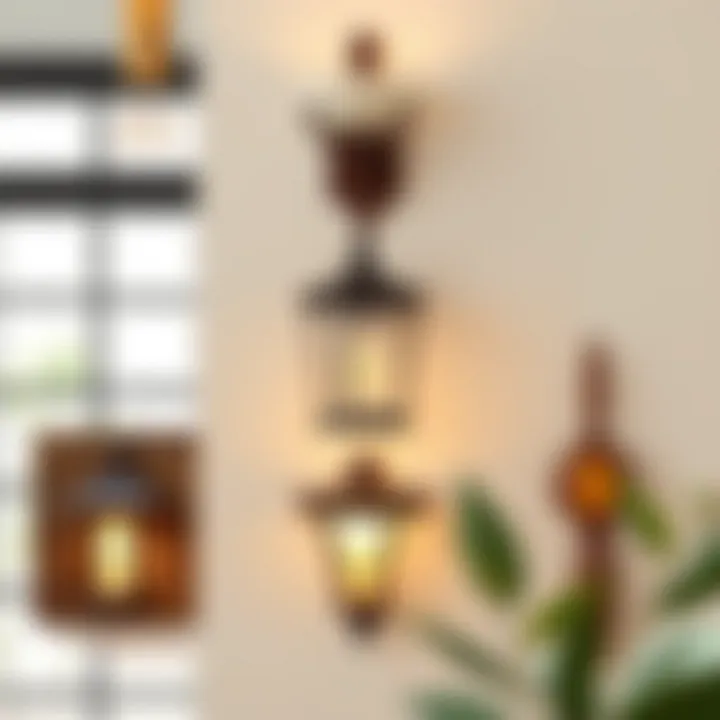
Considering Functionality
While aesthetics often take center stage, functionality should not be left in the shadows. Every sconce serves a purpose, whether it’s to provide ambient light, task light, or simply decoration. Identifying the function of your sconce can significantly impact your selection process. We're looking at three main aspects here:
- Ambient Light: If your goal is to provide overall lighting for a room, choose a sconce that has a softer diffusion, helping create a warm atmosphere without harsh glare. This is where paper sconces shine, offering a gentle glow.
- Task Lighting: For spaces where focused light is needed, such as reading nooks or detailed workstations, look for sconces that allow for certain adjustments. Fixtures that can tilt or pivot might be ideal to direct light where it’s needed most.
- Decorative Enhancements: Sometimes, the sconce’s purpose is simply to be a visual anchor. In this case, don’t hesitate to experiment with unique designs that speak to your individual taste, capturing a piece of Japanese culture while enhancing design cohesion.
Ultimately, the objective is to strike a balance between how the sconce looks and what it does. Finding the right fit elevates not just the sconce, but the entire vibe of your space.
Integration with Modern Interior Design
Japanese sconces offer a fascinating intersection between historical elegance and contemporary aesthetics. Their ability to harmonize with various styles underlines why they have become a cherished choice among designers and homeowners alike. The modern interior design landscape values versatility, and these fixtures provide a seamless way to add both character and functionality. When integrating Japanese sconces, one should consider several elements that can enhance the overall appeal of a space.
Blending Traditional and Contemporary Styles
Japanese sconces possess a unique charm that allows them to be incorporated into various design schemes, whether you lean towards a minimalist or eclectic approach. The gentle glow emitted by these fixtures can provide a serene atmosphere, balancing the more rigid lines of contemporary furniture with soft, organic silhouettes. Here are some key points to keep in mind:
- Material Synergy: The natural materials such as wood and paper used in Japanese sconces can soften the harshness of metal and glass elements commonly found in modern decor. For example, pairing a shoji screen-style sconce with sleek steel furniture creates an engaging conversation between designs.
- Form Meets Function: Traditional designs often emphasize simplicity and pragmatism. A wall-mounted sconce that doubles as a decorative piece can serve to illuminate while also adding texture and depth to a room.
- Cultural Touchstones: Integrating these sconces not only enhances aesthetics but also pays homage to the rich heritage of Japanese craftsmanship. This connection to history can provide a thoughtful layer amidst modern, minimalist setups.
Color Schemes and Lighting Techniques
Color schemes and lighting techniques are pivotal when incorporating Japanese sconces into modern spaces. The warm, diffused light they emit creates an inviting ambiance, making them suitable for varying moods and purposes.
- Harmonious Color Palettes: Opt for colors that complement the wooden finishes typical in Japanese sconces. Soft earth tones, muted greens, and subtle grays can form a cohesive scheme that enhances the natural beauty of the fixtures while tying in seamlessly with contemporary palettes.
- Layered Lighting: Using Japanese sconces as part of a layered lighting strategy can elevate a space's functionality and design. For example, when paired with recessed lighting or spotlights, sconces can create varying levels of brightness, bringing versatility to the room's atmosphere. A cozy reading nook illuminated by a sconce can transform into a vibrant social area when combined with brighter overhead lights.
- Contemporary Techniques: Embrace modern lighting technology with dimmable sconces. This adjustment can fine-tune the desired ambiance, making spaces more adaptable to different times of day or activities, from relaxed evenings to lively gatherings.
"The grace of Japanese sconces lies not only in their design but also in how they elevate the ambiance of any interior space, effortlessly bridging tradition with modernity."
Installation and Maintenance Tips
Installing and maintaining Japanese sconces properly ensures their longevity and functionality. Given their unique designs and cultural significance, it’s essential to pay attention to their placement and care. This not only enhances their aesthetic value but also preserves the harmony they add to a space. Let’s dive deeper into each aspect of installation and maintenance to facilitate optimal use of these beautiful light fixtures.
Choosing Optimal Placement
Placement is arguably more than just finding the right spot; it’s about creating the desired ambiance. Japanese sconces are often designed with a purpose beyond just lighting. When deciding where to place your sconces, consider the following:
- Functionality: What role will the sconce play? Is it for reading, ambiance, or both? Placing a sconce next to a chair can provide excellent lighting for reading without overpowering the room.
- Height Considerations: As a general rule, sconces should be mounted at eye level, generally between five to six feet from the floor. This ensures that they illuminate areas effectively without creating harsh shadows.
- Room Flow: Think about the flow of the room. For instance, if traffic often passes by a certain location, mount sconces slightly higher or choose a design that doesn't protrude too much from the wall to avoid accidents.
- Symmetry and Balance: Aesthetic appeal often comes from balance. Consider placing sconces at equal heights on either side of a feature, like a doorway or a piece of artwork, to create visual harmony.
Taking time to assess these elements will maximize the impact of your Japanese sconces.
Routine Care and Cleaning
Maintaining your sconces is vital for ensuring they continue to function optimally and look great. Japanese sconces often feature delicate materials, so cleaning requires a gentle touch. Here are some routine care tips:
- Dust Regularly: Dust can accumulate and dull the appearance of each sconce. Use a soft, dry cloth to gently wipe down the sconces at least once a month.
- Avoid Harsh Chemicals: Steer clear of abrasive cleaners. Instead, a mixture of warm water and mild soap can work wonders. If your sconce has a paper or fabric shade, damp cloth should be used sparingly, ensuring that water does not seep in.
- Check for Damage: Regularly inspect your sconces for signs of wear—like fraying wires or deteriorating materials. Addressing any damage early can prevent larger problems down the road.
- Replace Bulbs Mindfully: When changing bulbs, ensure that the wattage is appropriate for your sconce. Exceeding the recommended wattage can lead to overheating and damage.
"Proper installation and maintenance of sconces not only preserve their beauty but extend their lifespan, ensuring they remain a cherished aspect of your interior design."
Caring for your Japanese sconces is not just about routine cleaning; it’s about respecting the craftsmanship and cultural tradition they carry. By giving these fixtures the attention they deserve, you’ll cultivate an atmosphere that reflects both elegance and functionality in your living space.
Challenges and Considerations
When it comes to choosing Japanese sconces, understanding the associated challenges and considerations is essential. These fixtures not only provide functionality but also stand as pieces of art that reflect a culture steeped in tradition. Making thoughtful choices can elevate the aesthetics of any space while ensuring practical utility.
One primary challenge is navigating size and scale. Selecting a sconce that complements the proportions of a room can be tricky. Too large, and it may overwhelm the space; too small, and it might get lost against the backdrop of the environment.
Navigating Size and Scale
When hanging a Japanese sconce, consider the dimensions of both the fixture and the wall where it will be placed. A larger sconce, for example, can become a focal point in a spacious room, lending it character and warmth. Alternatively, in a compact living area, smaller sconces create intimacy without making the environment feel cluttered.
Here are a few tips for achieving the right balance:


- Measure the wall space: Check the height and width of the area where the sconce will hang. A general rule is to allow for 60-66 inches from the floor, depending on the ceiling height.
- Choose accordingly: If the fixture is particularly intricate, ensure it can capture attention without dominating the room. Experiment with their arrangement to see what feels best.
In addition to size, another important consideration is balancing ambiance with brightness. The primary purpose of lighting is to illuminate spaces, but the quality of that light and how it interacts with the rest of the room is critical to achieving a desirable atmosphere.
Balancing Ambiance with Brightness
Japanese sconces often favor softer lighting, designed to promote calmness and tranquility reminiscent of traditional Japanese aesthetics. However, this does not mean one should sacrifice brightness for ambiance. The art lies in achieving a harmony that allows spaces to be functional while exuding warmth.
Here are some strategies to strike that balance:
- Use dimmable options: Installing dimmable bulbs allows homeowners to adjust the lighting based on the time of day or activity, creating versatility in various contexts.
- Layer your lighting: Incorporate other sources of illumination, like floor or table lamps, to complement sconces. This technique not only enhances the lighting quality but also contributes depth and dimension to the overall ambiance.
- Consider bulb types: Certain bulbs cast a warmer light, which can help set the mood, while others provide a stark brightness. Assess your needs and pick bulbs that match the overall feel you are aiming for in the room.
"Light is not just a substance, but an experience that can elevate a simple space into something profoundly serene."
Combining these elements thoughtfully ensures that Japanese sconces serve their dual roles of aesthetic appeal and functionality. It allows designers, homeowners, and DIYers to create spaces that are both beautiful and practical, ultimately enhancing the character of their interiors.
Emerging Trends in Japanese Sconce Design
The realm of Japanese sconce design is undergoing a remarkable evolution as it melds traditional aesthetics with modern functionalities. This section will delve into two pivotal trends that are reshaping perspectives in the lighting domain: sustainable materials and practices, alongside technological innovations in lighting. These trends not only reflect contemporary values but also enhance the timeless appeal of Japanese sconces, attracting a diverse audience from homeowners seeking to beautify their living spaces, to designers looking for cultural authenticity and modernity.
Sustainable Materials and Practices
In an age where environmental consciousness is more critical than ever, the shift towards sustainable materials and practices in the world of Japanese sconces has gained momentum. This approach emphasizes eco-friendliness without compromising the elegance that defines these fixtures.
Japanese artisans are increasingly opting for materials that resonate with the principles of sustainability. For instance, bamboo and reclaimed wood have become favored choices due to their renewable nature. Bamboo, known for its rapid growth cycle, not only minimizes environmental impact but also brings a touch of natural beauty that complements the minimalist aesthetic often found in Japanese interiors.
Using traditional methods, artisans are adopting practices that reduce waste. Techniques like washi paper creation—which involves recycling and reusing materials—are integral to maintaining a low carbon footprint in production. When incorporated in sconces, the translucent nature of washi not only serves to diffuse light softly but also brings a culturally rich element that tells a story of heritage and craftsmanship.
Adopting sustainable materials has several advantages:
- Environmental Impact: Focus on renewable resources reduces deforestation and pollution.
- Aesthetic Diversity: Unique textures and colors from natural materials add depth to designs.
- Cultural Resonance: Using traditional crafting techniques promotes local artisan skills.
In light of these benefits, the choice of materials offers an appealing path for homeowners looking to blend beauty with environmental responsibility.
Technological Innovations in Lighting
As we step further into a digital age, the technological innovations in lighting are shaping the evolution of Japanese sconces. Smart home technology is not only pushing the boundaries of functionality but also enhancing the aesthetic experience.
Imagine sconces that can adjust brightness based on the time of day, or even mood. With the rise of smart home systems, Japanese sconces are now being designed with integrated LED technology that allows for customizable lighting. These advancements lead to a richer visual experience, adapting illumination to everyday needs and occasions—from creating a cozy atmosphere in the evening to brighter, focused light for activities like reading.
Additionally, the incorporation of energy-efficient LED bulbs supports a sustainable ethos while reducing electricity consumption. This transition ensures that users enjoy longer-lasting lighting solutions that are also low on their monthly bills. Yet, the essential beauty remains intact, as many of these innovative designs strive to harmonize with traditional aesthetics.
Here are key aspects to consider regarding technological innovations:
- Flexibility: Smart sconces can be programmed or controlled via mobile devices, creating an interactive experience.
- Energy Efficiency: LED technology dramatically cuts down energy usage compared to traditional bulbs.
- Design Variety: Contemporary designs that incorporate technology still honor traditional Japanese motifs, striking a balance between old and new.
"Embracing innovation while honoring tradition is where the true beauty of Japanese sconces lies."
Ending: The Enduring Charm of Japanese Sconces
In contemplating the allure and functionality of Japanese sconces, it becomes clear that these lighting fixtures are much more than mere sources of illumination. The unique blend of aesthetics and practicality they embody reflects the larger cultural ethos of Japan. In homes and public spaces alike, these sconces offer a warm welcome and invite reflection, evoking the serenity often associated with traditional Japanese design.
What stands out particularly is how Japanese sconces harmonize with their environments. Their designs often pay homage to nature, utilizing materials like washi paper and wood, which not only provide light but also narrate stories of craftsmanship and heritage. With their minimalist approach, these sconces allow for versatile integration across various interior styles, proving to be timeless assets in both ancient and modern settings.
In addition, the functionality of these sconces cannot be overlooked. They often serve practical purposes, like enhancing visibility in hallways or creating an inviting atmosphere in dining areas. Their versatility means they can illuminate a serene alcove or bring warmth to a busy living room, catering to different moods and functions.
Summary of Key Points
- Cultural Heritage: Japanese sconces encapsulate centuries of cultural progress and craftsmanship, making them significant not only as fixtures but as symbols of history.
- Design Versatility: The range of designs—from sleek and modern to ornate and traditional—ensures that there is a sconce for nearly any aesthetic preference.
- Functional Illumination: Beyond beauty, these sconces efficiently illuminate spaces, enhancing both ambiance and practicality in everyday life.
- Material Significance: The choice of materials used in making these sconces, such as bamboo, wood, and paper, reflects a deep respect for nature, further enhancing their charm.
Final Thoughts on Incorporation
Incorporating Japanese sconces into your own space can be a transformative experience. Whether you are updating a modern home or rejuvenating a traditional dwelling, these sconces can infuse your environment with character and warmth. They are not just decor items; they are conversation starters, providing insight into a rich cultural landscape.
For homeowners and designers, considering Japanese sconces is an opportunity to blend artistry with functionality. As much as they illuminate, they also contribute to the narrative of a space, inviting guests to pause and appreciate their gentle elegance. Keep in mind, selecting the right piece involves understanding both the aesthetic and functional requirements of your space.
Ultimately, Japanese sconces symbolize a commitment to quality, tradition, and design that transcends time. To embrace these fixtures is to celebrate a rich history while creating a harmonious ambiance in any setting.















